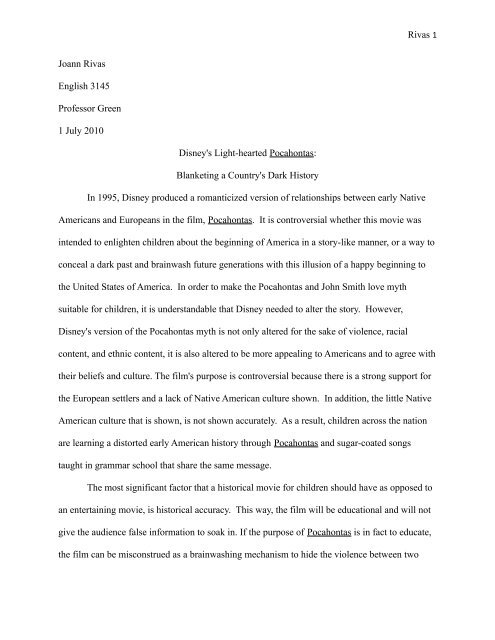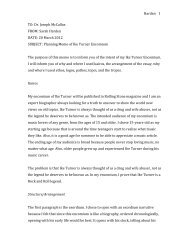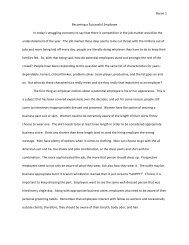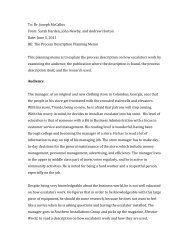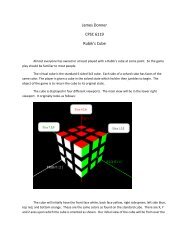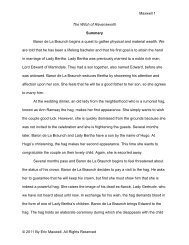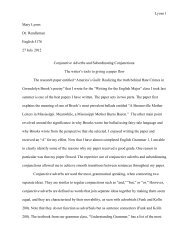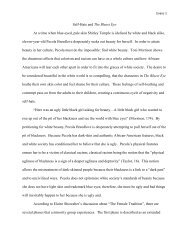Analysis on Pocahontas Myth - studentwebs.ColumbusState.edu
Analysis on Pocahontas Myth - studentwebs.ColumbusState.edu
Analysis on Pocahontas Myth - studentwebs.ColumbusState.edu
Create successful ePaper yourself
Turn your PDF publications into a flip-book with our unique Google optimized e-Paper software.
Rivas 1<br />
Joann Rivas<br />
English 3145<br />
Professor Green<br />
1 July 2010<br />
Disney's Light-hearted Pocah<strong>on</strong>tas:<br />
Blanketing a Country's Dark History<br />
In 1995, Disney produced a romanticized versi<strong>on</strong> of relati<strong>on</strong>ships between early Native<br />
Americans and Europeans in the film, Pocah<strong>on</strong>tas. It is c<strong>on</strong>troversial whether this movie was<br />
intended to enlighten children about the beginning of America in a story-like manner, or a way to<br />
c<strong>on</strong>ceal a dark past and brainwash future generati<strong>on</strong>s with this illusi<strong>on</strong> of a happy beginning to<br />
the United States of America. In order to make the Pocah<strong>on</strong>tas and John Smith love myth<br />
suitable for children, it is understandable that Disney needed to alter the story. However,<br />
Disney's versi<strong>on</strong> of the Pocah<strong>on</strong>tas myth is not <strong>on</strong>ly altered for the sake of violence, racial<br />
c<strong>on</strong>tent, and ethnic c<strong>on</strong>tent, it is also altered to be more appealing to Americans and to agree with<br />
their beliefs and culture. The film's purpose is c<strong>on</strong>troversial because there is a str<strong>on</strong>g support for<br />
the European settlers and a lack of Native American culture shown. In additi<strong>on</strong>, the little Native<br />
American culture that is shown, is not shown accurately. As a result, children across the nati<strong>on</strong><br />
are learning a distorted early American history through Pocah<strong>on</strong>tas and sugar-coated s<strong>on</strong>gs<br />
taught in grammar school that share the same message.<br />
The most significant factor that a historical movie for children should have as opposed to<br />
an entertaining movie, is historical accuracy. This way, the film will be <strong>edu</strong>cati<strong>on</strong>al and will not<br />
give the audience false informati<strong>on</strong> to soak in. If the purpose of Pocah<strong>on</strong>tas is in fact to <strong>edu</strong>cate,<br />
the film can be misc<strong>on</strong>strued as a brainwashing mechanism to hide the violence between two
Rivas 2<br />
cultures because it gives a false interpretati<strong>on</strong> of the Europeans and Native Americans's<br />
relati<strong>on</strong>ship. The reas<strong>on</strong> for leaving the physical violence out of the movie could not have been a<br />
policy of Disney producti<strong>on</strong>s, because physical violence is present in other Disney movies of this<br />
time period. For example, in Disney's film The Li<strong>on</strong> King, which was produced three years<br />
before Pocah<strong>on</strong>tas, there was both verbal and physical fighting am<strong>on</strong>g characters. In Disney's<br />
Mulan, the plot of the movie is a young woman who disguises her sex in order to join the<br />
military and fight for her country, and several war scenes are shown. Therefore, physical<br />
violence could not be a possible reas<strong>on</strong> why the Pocah<strong>on</strong>tas film was altered from reality.<br />
In additi<strong>on</strong> to blanketing the violence that occurred between these two cultures, Disney<br />
also hid aspects of the realistic Powhatan culture. For example, the Powhatan language was<br />
completely absent from the movie. Of course, the main plot of the story must be in English, but<br />
the slightest interacti<strong>on</strong>s in the native Alg<strong>on</strong>kian t<strong>on</strong>gue of the Powhatans would be a way to<br />
include the Native American culture, accurately. Also, the interacti<strong>on</strong> am<strong>on</strong>g each other in the<br />
tribe was the same interacti<strong>on</strong> seen in American society today. Pocah<strong>on</strong>tas is made to be quite<br />
liberal, as she roams around the river area al<strong>on</strong>e, where she is not allowed.<br />
Also similar to<br />
American family relati<strong>on</strong>ships, she rebels against her father's wishes and does not have an<br />
interest in Kacuom, the man her father wants her to have an interest in. Pocah<strong>on</strong>tas's rebelli<strong>on</strong><br />
makes the movie more interesting for an American audience, but drifts away from accurate<br />
history.<br />
While some aspects of Native American culture were ignored, such as their language and<br />
manner in relati<strong>on</strong>ships, the Powhatans's interacti<strong>on</strong>s with nature were exaggerated. Their<br />
spiritual beliefs were shown as imaginary and magical, such as the talking tree that Pocah<strong>on</strong>tas<br />
often visits, Grandmother Willow, and Pocah<strong>on</strong>tas's best friends, a racco<strong>on</strong> and a hummingbird.
Rivas 3<br />
There are two introductory s<strong>on</strong>gs that set stereotypes for both cultures for the rest of the movie.<br />
The first s<strong>on</strong>g is played when the Europeans arrive to the new land and it is called The Virginia<br />
Company, “For the new world is like heaven, and we’ll all be rich and free, or so we have been<br />
told by the Virginia Company.” This s<strong>on</strong>g portrays the Europeans as civilized, productive people<br />
with goals to earn m<strong>on</strong>ey, glory, freedom, and the land of the natives. The sec<strong>on</strong>d s<strong>on</strong>g is played<br />
about the Native Americans and it is called Steady as the Beating Drum, “Seas<strong>on</strong>s go and<br />
seas<strong>on</strong>s come, steady as the beating drum… Oh great spirit hear our s<strong>on</strong>g, help us keep the<br />
ancient ways, keep the sacred fire str<strong>on</strong>g.” This s<strong>on</strong>g is nature-oriented with no relevance to any<br />
other aspect of the Natives’s lives. The Native Americans were highly spiritual people and in<br />
touch with nature, but their purpose for living is not established as the s<strong>on</strong>g for the Europeans<br />
did. Therefore, they are shown without a purpose or plan, and <strong>on</strong>ce again their culture is<br />
portrayed as imaginary and magical.<br />
Finally, as the Powhatan's interacti<strong>on</strong>s with nature is dramatized, their pers<strong>on</strong>al morals<br />
and values are Americanized. Relati<strong>on</strong>ships, female roles, and male roles are changed from<br />
Powhatan beliefs to that of Americans. Was it to make the movie more relatable to the American<br />
people or to enforce to children that Natives and Europeans were similar and therefore<br />
compatible? This would make the grammar school s<strong>on</strong>gs about the harm<strong>on</strong>ious first<br />
Thanksgiving more believable, after all. Just as women hold a lower positi<strong>on</strong> in American<br />
society, Pocah<strong>on</strong>tas and other women in the movie did, as well. This was so obvious that<br />
Pocah<strong>on</strong>tas was the <strong>on</strong>ly <strong>on</strong>e of two women characters to speak in the entire movie.<br />
However, in Powhatan society, women's roles were as difficult as men's roles. Women<br />
were in charge of producing vegetati<strong>on</strong>, caring for domestic duties, making pottery and clothing,<br />
while men were in charge of hunting for meat and fur and for protecting the tribe. Women's
Rivas 4<br />
opini<strong>on</strong>s were respected in the Powhatan culture, which could be why the Chief accepted<br />
Pocah<strong>on</strong>tas's wishes not to kill John Smith in real life. Dundes believes that Disney's versi<strong>on</strong> <strong>on</strong><br />
this scene, <strong>on</strong>e of the most important scenes of the movie, portrays a Powhatan woman's role<br />
correctly, "She tells the chief, which is her father, not to hurt or kill John Smith, and her voice is<br />
heard." However, Disney quickly takes away this female's hierarchy with Pocah<strong>on</strong>tas's line,<br />
"But I love him." Dundes says, “Her acti<strong>on</strong>s, while overtly heroic, with far-fetching<br />
c<strong>on</strong>sequences, center around a relati<strong>on</strong>ship—her feelings and urge to protect the object of her<br />
love, which is a feminine role” (2). In other words, her acti<strong>on</strong>s are based <strong>on</strong> emoti<strong>on</strong>s rather than<br />
rati<strong>on</strong>al thought, which is most comm<strong>on</strong>ly a role portrayed in women, more specifically<br />
American women. The fact that she is being heard is positive, but it is because of her emoti<strong>on</strong>s<br />
and she is standing against her father and her tribe for the European man, John Smith.<br />
Dundes explores another reas<strong>on</strong> behind Disney’s choice to make Pocah<strong>on</strong>tas be portrayed<br />
with female gender roles and be so nurturing to John Smith, “Pocah<strong>on</strong>tas’ acti<strong>on</strong>s also<br />
corresp<strong>on</strong>d to age-old depicti<strong>on</strong>s of admirable American Indian women as those who save and<br />
aid White men, are the object of White men’s sexual desire…” (2). Therefore, Pocah<strong>on</strong>tas’s<br />
acti<strong>on</strong>s could be based <strong>on</strong> the perspective of American, male creators of the film. Borthaiser<br />
questi<strong>on</strong>s the same c<strong>on</strong>cept when analyzing the physique of Pocah<strong>on</strong>tas, since the thirteen year<br />
old Pocah<strong>on</strong>tas who met John Smith is shown as a woman in Disney's film, “Glean Keane,<br />
supervisor animator of Pocah<strong>on</strong>tas, claims that she was based <strong>on</strong> American models, but is<br />
‘different than the Caucasian kind of look’. Pocah<strong>on</strong>tas is ‘more of a woman than a teenager’<br />
and with this change comes sexuality. Her voluptuous body reflects the Western male visi<strong>on</strong> <strong>on</strong><br />
exotic women: she has the body of a Western woman but has the exotic features that make her<br />
other than Western women” (1). Dundes’s explanati<strong>on</strong> for this is that “When a Disney animati<strong>on</strong>
Rivas 5<br />
is made <strong>on</strong> another culture, it cannot be produced without the interference of Western paradigms”<br />
(2). Western paradigms are<br />
also evident in a few added and deleted scenes throughout the film. For example, Disney<br />
manages to add a scene in the film where John Smith dodges a bullet aimed at the Chief of the<br />
Powhatan tribe. There is no evidence that this occurred in early American history, but Disney's<br />
reas<strong>on</strong> for adding it into the movie could be to have a peaceful European, as Pocah<strong>on</strong>tas is the<br />
peaceful Native American. Disney's Pocah<strong>on</strong>tas did not incorporate the issue of race, which was<br />
the main reas<strong>on</strong> of the dispute between the two people. In Pocah<strong>on</strong>tas, both cultures are<br />
oblivious of the significant difference in each other's skin color. This was an extreme shock for<br />
both the Native Americans and Europeans to see a people so different, but this issue is swept<br />
under the table by Disney, since an issue so grand would make it more difficult to have a<br />
harm<strong>on</strong>ious ending. Also, it would be unlikely that a people so different would fall in love<br />
during this time period.<br />
It is also<br />
interesting how such a detailed romance was created about Pocah<strong>on</strong>tas and John Smith when<br />
their relati<strong>on</strong>ship is truly ambiguous. The little informati<strong>on</strong> that is known about Pocah<strong>on</strong>tas and<br />
John Smith's interacti<strong>on</strong> is that there was a significant age difference in the two. John Smith<br />
does not discuss Pocah<strong>on</strong>tas in detail in his writings, so the possibility of an intimate relati<strong>on</strong>ship<br />
between the two of them is unlikely. In additi<strong>on</strong>, the dramatic differences between the two<br />
people's skin color, culture, language, and lifestyle made it unlikely that they would have a<br />
relati<strong>on</strong>ship of any kind, since naturally humans are afraid of the unknown, and also neither were<br />
immune to the other's bacteria. If these facts are so, why does early childhood <strong>edu</strong>cati<strong>on</strong> dwell <strong>on</strong><br />
the Pocah<strong>on</strong>tas and John Smith legend rather than teach history with evidence that proves its<br />
occurrence?<br />
Instead
Rivas 6<br />
of giving facts, grammar school creates a child friendly celebrati<strong>on</strong> throughout fall seas<strong>on</strong>, to<br />
enforce the same false informati<strong>on</strong> as Disney's Pocah<strong>on</strong>tas. Children are taught about Native<br />
Americans as a whole people, rather than individual people with their own tribes and cultures.<br />
Natives and their early relati<strong>on</strong>ship with Europeans sound so pleasant since the deaths, spread of<br />
disease, and slaughter of cultures are excluded. I remember singing s<strong>on</strong>gs about harm<strong>on</strong>y and<br />
the friendship of the two cultures as they shared American land and celebrated with the first<br />
Thanksgiving dinner: "The Pilgrims learned from the Indians/ How to hunt wild turkey and deer./<br />
They learned to fish and to plant corn,/ Had food to eat throughout the year." I cannot fathom<br />
why the deaths, disease, and dying cultures were replaced with turkey, cornucopias, and love. Of<br />
course, it would not make sense to teach a class of eight-year-olds about such a sad story, but the<br />
truth is being stretched too far by calling the Natives and Pilgrims best friends. There is also the<br />
infamous s<strong>on</strong>g, "This land is your land, this land is my land," which also gives children the<br />
illusi<strong>on</strong> that there was not problem in maintaining peace in the 1700's. Unfortunately, after being<br />
taught this c<strong>on</strong>cept for about ten years, children go into high school with a prec<strong>on</strong>ceived noti<strong>on</strong><br />
of early American history.<br />
High school is spent admiring<br />
the European heroes that helped civilize the "savages" in New England. C<strong>on</strong>flict am<strong>on</strong>g the<br />
Europeans and Natives is finally revealed in high school, but the inequality towards the Native<br />
Americans is not the main focus of a typical less<strong>on</strong>. Instead, Europeans are glorified for having<br />
goals for America and learning about the goal of manifest destiny seems to overshadow that of<br />
The Trail of Tears. N<strong>on</strong>etheless, what I gathered in high school was that the disputes between the<br />
two cultures were irrelevant since little had been menti<strong>on</strong>ed about them in school. In additi<strong>on</strong>,<br />
my grammar school singing and Disney movie watching, there was a harm<strong>on</strong>ious feast that<br />
united these people and Pocah<strong>on</strong>tas and John Smith helped blend the two cultures.
Rivas 7<br />
However, The Bedford Anthology of American<br />
Literature reveals that the beginning of early America involved several hardships for both the<br />
European and Native American people. Pocah<strong>on</strong>tas' life is shown in a different way than it was<br />
in American stereotypes. Rather than Pocah<strong>on</strong>tas and John Smith having a romantic<br />
relati<strong>on</strong>ship, and the Native Americans and Europeans being the best of neighbors, the anthology<br />
h<strong>on</strong>estly states the hardships for both parties. After the Europeans sailed sixty-six days and faced<br />
several deaths of their people, they arrived to the Americas. With the arrival of these<br />
newcomers, a great majority of Natives died when coming in c<strong>on</strong>tact with the Europeans because<br />
they were not immune to the bacteria and diseases they carried. Several European encounters<br />
with the Native Americans were recorded through manuscript such as John Smith's encounter<br />
with Pocah<strong>on</strong>tas and the Powhatan people.<br />
John Smith barely menti<strong>on</strong>s Pocah<strong>on</strong>tas in<br />
his writings, and what he does say about her hints no kind of intimate relati<strong>on</strong>ship between the<br />
two. The Bedford Anthology has a passage from The Generall Historie of Virginia, New-<br />
England, and the Summer Isles, describing John Smith's interacti<strong>on</strong> with Powhatan, and nearly<br />
being killed by the Native Americans. However, as the natives were "ready with their clubs, to<br />
beate out his braines, Pocah<strong>on</strong>tas the Kings dearest daughter, when no intreaty could prevaile,<br />
got his head in her armes, and laid her owne up<strong>on</strong> his to save him from death," he menti<strong>on</strong>s how<br />
the Powhatan princess saves his life. Smith briefly menti<strong>on</strong>s Pocah<strong>on</strong>tas's presence, besides the<br />
fact that she saved his life (119). The c<strong>on</strong>text of his writing c<strong>on</strong>veys her as another "savage," yet<br />
Disney portrays their relati<strong>on</strong>ship as being harm<strong>on</strong>ious and romantic.<br />
The Bedford Anthology of American Literature also<br />
gives informati<strong>on</strong> of Pocah<strong>on</strong>tas's life after her meeting John Smith. As for Pocah<strong>on</strong>tas's<br />
romantic life, she does have a relati<strong>on</strong>ship with a European, but not with John Smith, and not as
Rivas 8<br />
willingly as she was in the Disney film as she frolicked al<strong>on</strong>g the Virginia forests. Pocah<strong>on</strong>tas<br />
was kidnapped by the Europeans, taught English, c<strong>on</strong>verted to Christianity, and finally became<br />
Mrs. Rebecca Rolfe after marrying John Rolfe. Her husband then brought her to England where<br />
she became infected with tuberculosis and died.<br />
Pocah<strong>on</strong>tas' popularity began as a celebrati<strong>on</strong> of her being civilized by the Europeans,<br />
since it was proof that the "savages" of the new world could be domesticated into the European<br />
ways of life. However as time passed, the devastati<strong>on</strong> that the Native Americans faced brought<br />
up<strong>on</strong> another reas<strong>on</strong> to admire the Pocah<strong>on</strong>tas myth: the reas<strong>on</strong> this ambiguous woman grew so<br />
popular to the American culture could be because she is a symbol of a somewhat positive<br />
relati<strong>on</strong>ship between these two cultures. As Disney did, erasing the kidnapping, the force into<br />
Christianity, and marriage, and the lethal trip to England, what is left is a husband and wife of<br />
different races, a people so different, living harm<strong>on</strong>iously.<br />
It is important for children in grammar school to be introduced to different parts of early<br />
American history. If Disney can produce child-friendly movies that include disputes such as The<br />
Li<strong>on</strong> King and Mulan, a movie that serves as a historically <strong>edu</strong>cati<strong>on</strong>al movie should have<br />
permissi<strong>on</strong> to include realistic disputes between the European and Native Americans. If early<br />
childhood <strong>edu</strong>cators want to teach about the first Thanksgiving, the children should be given an<br />
age-appropriate less<strong>on</strong> <strong>on</strong> the hardships that our ancestors, whether European and Native<br />
American, went through in order to gain a civil interacti<strong>on</strong> with <strong>on</strong>e another. By preparing<br />
American youth with the United States history that does not have gaps, they will be better<br />
prepared to comprehend when these topics are discussed more thoroughly in their higher levels<br />
of <strong>edu</strong>cati<strong>on</strong>.<br />
Works Cited
Rivas 9<br />
Borthaiser, Nóra (2008). A Whole New World [Electr<strong>on</strong>ic Versi<strong>on</strong>]. Americana: E-journal of<br />
American Studies in Hungary, 4, 5-5.<br />
Dundes, Lauren (2001). Disney's Modern Heroine Pocah<strong>on</strong>tas: Revealing Age-Old Gender<br />
Stereotypes and Role Disc<strong>on</strong>tinuity Under a Facade of Liberati<strong>on</strong> [Electr<strong>on</strong>ic Versi<strong>on</strong>].<br />
Giamo, Michael. Pocah<strong>on</strong>tas. Disney, 1995. Film.<br />
Smith, John. From The Generall Historie of Virginia, New-England, and the Summer Isles. The<br />
Bedford Anthology of American Literature. Bedford: Bost<strong>on</strong>, 2008: P. 110-119.


